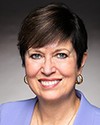Semi-automatic action is—and this is quoting Murray Smith from the RCMP—“where much of the loading action is done automatically by the firearm. It's kind of like having an automatic transmission on a car versus a standard.” It is automatic for the user.
All of these actions, like bolt, lever, hinge and pump—actions that require more manual effort to reload—remain unaffected by this new proposed definition. For folks following along at home, we're talking about guns that fire larger bullets and for which most of the loading is done automatically. This seems pretty reasonable to me, and it certainly does to the members on this side.
The next criterion that must be met is a firearm that “was originally designed with a detachable cartridge magazine with a capacity of six cartridges or more”. Again, for those at home, we can refer to cartridges colloquially as bullets. It's also important to note that the legal magazine capacity in Canada is five. Anything larger is deemed to be too big and is illegal. We're only talking about guns that fire a large number of bullets, where much of the loading action is done automatically. The definition is forward-looking only. It applies only to guns that have not been invented yet.
In the amendments I submitted yesterday, I also included a provision that will ensure that there's a five-year legislative review of this definition to ensure the right balance has been struck.
In summary, this definition only applies to future guns that are designed to fire a large number of big bullets, where much of the loading action is done automatically. In the words of Canadian Doctors for Protection from Guns, these amendments are “A victory for science, public health, and Canadian values”.
What we have before us is a reasonable and technical definition. It also—and I want to stress this—does not take away from the firearms that were deemed prohibited in the 2020 order in council that banned 1,500 kinds of assault-style firearms, including the AR-15, from our country. Those firearms remain prohibited.
Today what we have before us are new amendments, including a new technical definition that provides clarity and sets an objective standard of what constitutes a prohibited weapon. It's a technical definition that the majority of Canadians support, and it was supported by the Mass Casualty Commission.
I've been on this public safety committee since I was elected in 2015. I've met with and listened to survivors of gun violence, domestic abuse and mass shootings, who have worked with our government to introduce legislation to strengthen gun control and enhance our public safety. That's why, in my community of Oakville North—Burlington, I hear from my constituents about the need to strengthen our gun control laws. One life lost to gun violence is one too many.
As someone who has advocated for eight years for a strategy to address and prevent gun violence, it gives me great pride to be part of a government that's introduced this legislation, which is the strongest piece of gun control legislation in our lifetimes.
I was really disappointed to see that already my colleagues across the way in the Conservative Party are spreading misinformation. Bill C-21 is a strong piece of legislation, and it has important aspects beyond the technical definition I've talked about today. Canadians are concerned about their safety and about gun violence. There isn't a one-size-fits-all solution to address gun violence and crime, but Bill C-21 is one tool in our tool box to address gun violence specifically and to ban guns that were designed to kill the most people in the shortest amount of time. It will bolster border and law enforcement capacity, reduce the number of firearms in circulation in Canada, stop gun crime before it starts, create red-flag and yellow-flag laws, and provide resources to help combat domestic violence involving firearms.
We're making critical investments in housing, mental health supports and youth programs to address the root causes of crime and to set young people up for success. We also created the first-ever action plan to end gender-based violence. All these investments and actions by our government, including Bill C-21, are part of our government's broader strategy to keep Canadians safe and healthy. Bill C-21 is a critical bill that needs to be passed as soon as possible.
I just want to reiterate, Mr. Chair, that we all need to be taking a public health approach to gun control. This is one part of that approach.
I call on my colleagues to support this amendment. Thank you.





